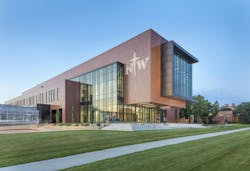“Life Cycle” Thinking Drives Sustainable Building Efforts
As builders grow more interested in sustainable practices and certifications, they’re turning their attention to products with life cycle assessments (LCAs). An LCA offers building design teams a broad look at the environmental impacts of a given building product through all phases of its life cycle. LCAs offer scientific measurement of a product’s environmental qualities, so builders can make informed choices with their construction materials.
One manufacturer in the construction products space backing up its claims of sustainability with a dedication to LCAs is Sherwin-Williams. As one of the first coating companies in the industry to build out an LCA program, Sherwin-Williams uses the LCA process to develop environmental product declarations (EPDs), which standardize environmental impact information in a transparent way. These EPDs are used by green building programs like LEED to verify and outline the sustainability impacts of various products.
Sherwin-Williams has a full-time team dedicated to performing life cycle assessments. Doug Mazeffa, Global Sustainability Director at Sherwin-Williams, said the LCA process looks at everything from the raw materials used in the manufacturing process to packaging and usage considerations. This advanced technical process uses software to model a whole value chain. This analysis allows companies to quantify impacts into “indicator areas” including carbon, water, ozone depletion, and many others.
Mazeffa said a focus on life cycle and longevity is especially important when it comes to coil coatings since they protect the metal building materials they’re placed on. For example, if a coating fails on the outside of a skyscraper, a replacement can be costly and involve substantial carbon emissions throughout the entire process of removing, manufacturing and installation.
“If the coating fails, that leads to the substrate failing,” Mazeffa said. “That protection element is a critical consideration because it's not just the impact of our coating. It's replacing a giant heavy sheet of metal.”
Christian Zimprich, Marketing Manager for Coil Coatings at Sherwin-Williams, said it’s crucial to take a holistic approach to the life cycle concept. He describes two ways of looking at LCA: cradle-to-gate and cradle-to-grave. Cradle-to-gate LCA assesses the product life cycle from resource extraction to production, taking a closer look at the materials used and the production methods and impacts. While this has its uses, cradle-to-grave LCA provides a broader perspective, instead offering a look at the entire life of a product, from resource extraction, through its use and disposal. While a coating may be produced in a sustainable manner, it needs to also offer longevity and environmental benefits through its entire lifecycle in order to make the most impact in its sustainability profile.
“It's very easy for us to make a coating that we would characterize as more environmentally friendly. But if it only lasts one year versus 50, then you're doing a lot more damage, ”Zimprich said. “The longer the coating lasts, the longer the lifespan of the building itself.”
Beyond maximizing the lifespan of a given building and the materials that it’s made up of, it’s equally important that these materials are recyclable after their useful life.
“If the whole building ends up in a landfill, that's a much more significant impact on the environment than if you're able to take a large portion of that building and recycle it and make another building,” Zimprich points out. This is the benefit of metal as a building material: it’s inherently long-lasting, and once it has reached the end of its useful life, it can be recycled to create something new.
Metal coatings like Sherwin-Williams’ Fluropon product line are designed to protect the metal substrate for decades. The 70 percent PVDF coating offers lasting protection against corrosion and features high film integrity and resistance to UV rays.
Ultimately, Mazeffa said he’s seen growing interest in LCAs from the industry, as builders look to put up structures that last while requiring minimal maintenance.
Mazeffa noted that opting for metal and coil coatings can help builders make a positive environmental impact, rather than simply reducing their negative impacts.
“Although it's really important to be working to decrease your environmental footprint—or ’do less bad’—what I personally love is those products like coil that have a sustainability benefit associated with them,” Mazeffa said. “You can not only decrease your footprint, but you can also improve your benefit.”

